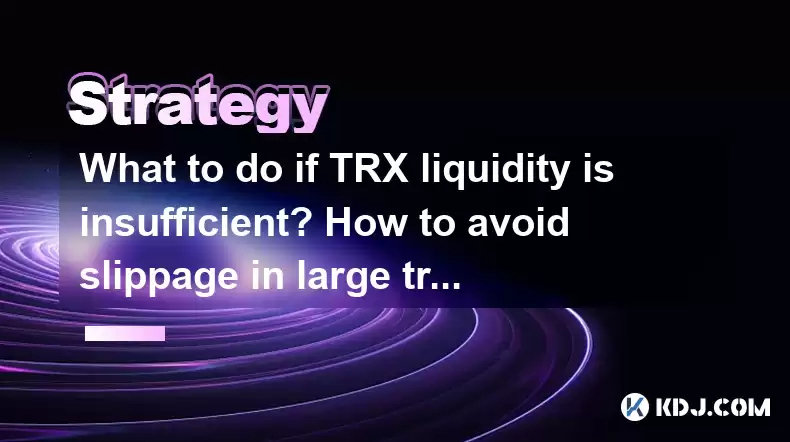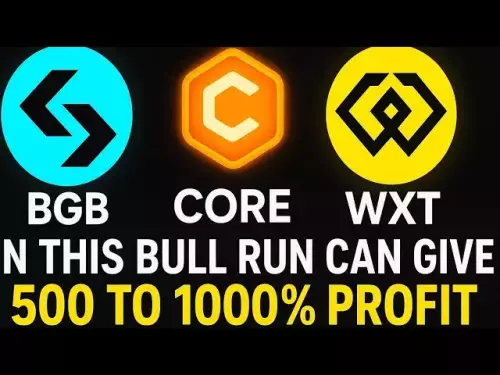-
 bitcoin
bitcoin $110311.910091 USD
1.97% -
 ethereum
ethereum $3964.172463 USD
0.34% -
 tether
tether $1.000288 USD
-0.05% -
 bnb
bnb $1098.563056 USD
-0.37% -
 xrp
xrp $2.479902 USD
4.31% -
 solana
solana $188.301025 USD
1.38% -
 usd-coin
usd-coin $0.999961 USD
0.01% -
 tron
tron $0.322477 USD
0.49% -
 dogecoin
dogecoin $0.199450 USD
2.51% -
 cardano
cardano $0.662393 USD
2.33% -
 hyperliquid
hyperliquid $37.947663 USD
1.71% -
 chainlink
chainlink $18.819081 USD
9.53% -
 ethena-usde
ethena-usde $0.999345 USD
-0.04% -
 stellar
stellar $0.323467 USD
2.06% -
 bitcoin-cash
bitcoin-cash $479.282126 USD
1.50%
What to do if TRX liquidity is insufficient? How to avoid slippage in large transactions?
Low TRX liquidity can cause slippage; use DEXs, liquidity pools, and split orders to manage large transactions effectively.
Apr 29, 2025 at 07:56 am

Understanding TRX Liquidity Issues
Insufficient liquidity in the TRX (Tron) market can lead to significant challenges for traders and investors, particularly when executing large transactions. Liquidity refers to the ability to buy or sell an asset without causing a significant change in its price. When liquidity is low, the market may not have enough buyers or sellers to absorb large orders, which can result in slippage—the difference between the expected price of a trade and the price at which the trade is executed. This article will explore strategies to manage and mitigate these issues when dealing with TRX.
Strategies to Improve TRX Liquidity
To address insufficient liquidity, consider the following approaches:
Use Decentralized Exchanges (DEXs): DEXs like JustSwap on the Tron network often provide better liquidity for TRX than centralized exchanges. They operate on automated market makers (AMMs) which can handle large volumes without as much slippage.
Liquidity Pools: Participate in or create liquidity pools. By adding your TRX to a pool, you help increase the overall liquidity and can earn trading fees as a reward.
Timing Your Trades: Execute your trades during peak trading hours when liquidity is typically higher. This can reduce the impact of your large orders on the market price.
Splitting Large Orders: Instead of placing one large order, split it into smaller ones. This can help minimize the impact on the market and reduce slippage.
How to Avoid Slippage in Large TRX Transactions
Slippage is a critical concern for those dealing with large volumes of TRX. Here are detailed steps to minimize slippage:
Set Slippage Tolerance: On most DEXs, you can set a slippage tolerance. A higher tolerance means your trade is more likely to execute, but at a potentially less favorable price. A lower tolerance may result in the trade not executing if the market moves too quickly.
Use Limit Orders: Instead of market orders, use limit orders to specify the exact price at which you are willing to buy or sell. This can prevent slippage but may delay the execution of your trade if the market does not reach your specified price.
Monitor Market Depth: Before executing a large order, check the order book to understand the market depth. This can give you an idea of how much your order might move the market price.
Trade on Multiple Exchanges: Spread your order across multiple exchanges to reduce the impact on any single market. This can help manage slippage by distributing the volume.
Practical Steps for Executing Large TRX Transactions
Here is a step-by-step guide on how to execute a large TRX transaction with minimal slippage:
Choose the Right Platform: Select a platform known for its liquidity in TRX, such as a reputable DEX or centralized exchange.
Analyze the Market: Use tools like TradingView to monitor TRX price movements and market sentiment. This can help you time your trade more effectively.
Prepare Your Order: Decide whether to use a limit order or split your order into smaller chunks. Set your slippage tolerance if using a DEX.
Execute the Trade: Place your order according to your strategy. If using multiple exchanges, monitor each order closely.
Monitor and Adjust: Keep an eye on your trades. If necessary, adjust your orders based on market movements to minimize slippage.
Tools and Resources for TRX Trading
To effectively manage TRX liquidity and slippage, consider using the following tools and resources:
Trading Bots: Automated trading bots can help execute your strategies more efficiently. They can split orders and monitor markets 24/7.
Liquidity Aggregators: Services like 1inch or ParaSwap can find the best liquidity across multiple DEXs, potentially reducing slippage.
Price Alerts: Set up price alerts to notify you when TRX reaches certain thresholds, allowing you to execute your trades at optimal times.
TRX Analytics Platforms: Use platforms like CoinMarketCap or CoinGecko to get real-time data on TRX liquidity and market depth.
Case Study: Managing a Large TRX Transaction
Consider the following hypothetical scenario to illustrate how to manage a large TRX transaction:
Scenario: You need to sell 1 million TRX. The current market price is $0.05 per TRX, and you want to minimize slippage.
- Action Plan:
- Choose Platform: Use a DEX like JustSwap, known for its liquidity in TRX.
- Set Slippage Tolerance: Set a slippage tolerance of 1% to ensure your order executes without too much price impact.
- Split the Order: Divide the 1 million TRX into 10 orders of 100,000 TRX each.
- Use Limit Orders: Set limit orders at $0.0495 per TRX to ensure you get a price close to the market rate.
- Monitor and Adjust: Watch the market closely and adjust your orders if necessary to respond to price movements.
By following this plan, you can execute your large TRX transaction with minimal slippage and maintain control over the price at which you sell.
Frequently Asked Questions
Q: Can I improve TRX liquidity by staking my tokens?A: Staking TRX can contribute to the overall health of the Tron network, but it does not directly improve liquidity in the trading markets. To enhance liquidity, consider adding your TRX to liquidity pools or trading on platforms with high TRX volume.
Q: How does the Tron network's performance affect TRX liquidity?A: The performance of the Tron network, including transaction speed and fees, can indirectly influence TRX liquidity. A well-performing network can attract more users and traders, potentially increasing liquidity. However, the primary factors affecting liquidity are market demand and the presence of liquidity providers on trading platforms.
Q: Is it possible to predict TRX liquidity based on historical data?A: While historical data can provide insights into past liquidity trends, predicting future liquidity with high accuracy is challenging. Liquidity is influenced by numerous factors, including market sentiment, regulatory news, and global economic conditions. Traders can use historical data to make informed decisions but should remain aware of current market conditions.
Q: How can I find the best time to trade TRX to maximize liquidity?A: The best times to trade TRX for maximum liquidity are typically during peak trading hours, which often coincide with the opening hours of major financial markets like those in New York, London, and Tokyo. Additionally, monitoring trading volume and market depth on your chosen trading platform can help you identify optimal trading times.
Disclaimer:info@kdj.com
The information provided is not trading advice. kdj.com does not assume any responsibility for any investments made based on the information provided in this article. Cryptocurrencies are highly volatile and it is highly recommended that you invest with caution after thorough research!
If you believe that the content used on this website infringes your copyright, please contact us immediately (info@kdj.com) and we will delete it promptly.
- Crypto Coins: Ethereum, Solana, and the Rise of AI in 2025
- 2025-10-21 08:45:16
- TRON's Stablecoin Empire: Cross-Chain Expansion and Blockchain Innovations
- 2025-10-21 08:45:16
- Shiba Inu, AlphaPepe, Presale: The Meme Coin Evolution
- 2025-10-21 08:50:01
- Dogecoin, Whales, and Bullish Alternatives: What's the Deal?
- 2025-10-21 08:50:01
- Shohei Ohtani, World Series, and Baseball Fever: A Los Angeles Love Affair
- 2025-10-21 08:50:01
- Ethena's Expansion: New Products and Team Growth on the Horizon
- 2025-10-21 08:50:12
Related knowledge

Practical parameter settings for a Bitcoin multi-timeframe moving average system
Sep 18,2025 at 10:54pm
Optimizing Timeframe Combinations for Bitcoin Trading1. Selecting appropriate timeframes is crucial when building a multi-timeframe moving average sys...

How can I filter out false breakouts in Dogecoin high-frequency trading?
Sep 22,2025 at 01:00am
Understanding False Breakouts in Dogecoin Trading1. A false breakout occurs when Dogecoin's price appears to move beyond a defined support or resistan...

Techniques for identifying tops and bottoms in the Bitcoin on-chain NVT model
Sep 20,2025 at 07:54pm
Understanding the NVT Model in Bitcoin Analysis1. The Network Value to Transactions (NVT) ratio is often described as the 'P/E ratio' of the cryptocur...

What does the surge in open interest in Bitcoincoin futures mean?
Sep 20,2025 at 11:18pm
Understanding the Surge in Dogecoin Futures Open Interest1. A surge in open interest within Dogecoin futures indicates a growing number of active cont...

How can I use the Ethereum USDT premium to gauge market sentiment?
Sep 18,2025 at 11:55pm
Understanding the Ethereum USDT Premium1. The Ethereum USDT premium refers to the price difference between USDT (Tether) traded on Ethereum-based plat...

What should I do if Ethereum staking yields decline?
Sep 20,2025 at 06:18am
Understanding the Causes Behind Declining Ethereum Staking Yields1. The Ethereum network transitioned to a proof-of-stake consensus mechanism with the...

Practical parameter settings for a Bitcoin multi-timeframe moving average system
Sep 18,2025 at 10:54pm
Optimizing Timeframe Combinations for Bitcoin Trading1. Selecting appropriate timeframes is crucial when building a multi-timeframe moving average sys...

How can I filter out false breakouts in Dogecoin high-frequency trading?
Sep 22,2025 at 01:00am
Understanding False Breakouts in Dogecoin Trading1. A false breakout occurs when Dogecoin's price appears to move beyond a defined support or resistan...

Techniques for identifying tops and bottoms in the Bitcoin on-chain NVT model
Sep 20,2025 at 07:54pm
Understanding the NVT Model in Bitcoin Analysis1. The Network Value to Transactions (NVT) ratio is often described as the 'P/E ratio' of the cryptocur...

What does the surge in open interest in Bitcoincoin futures mean?
Sep 20,2025 at 11:18pm
Understanding the Surge in Dogecoin Futures Open Interest1. A surge in open interest within Dogecoin futures indicates a growing number of active cont...

How can I use the Ethereum USDT premium to gauge market sentiment?
Sep 18,2025 at 11:55pm
Understanding the Ethereum USDT Premium1. The Ethereum USDT premium refers to the price difference between USDT (Tether) traded on Ethereum-based plat...

What should I do if Ethereum staking yields decline?
Sep 20,2025 at 06:18am
Understanding the Causes Behind Declining Ethereum Staking Yields1. The Ethereum network transitioned to a proof-of-stake consensus mechanism with the...
See all articles










































































